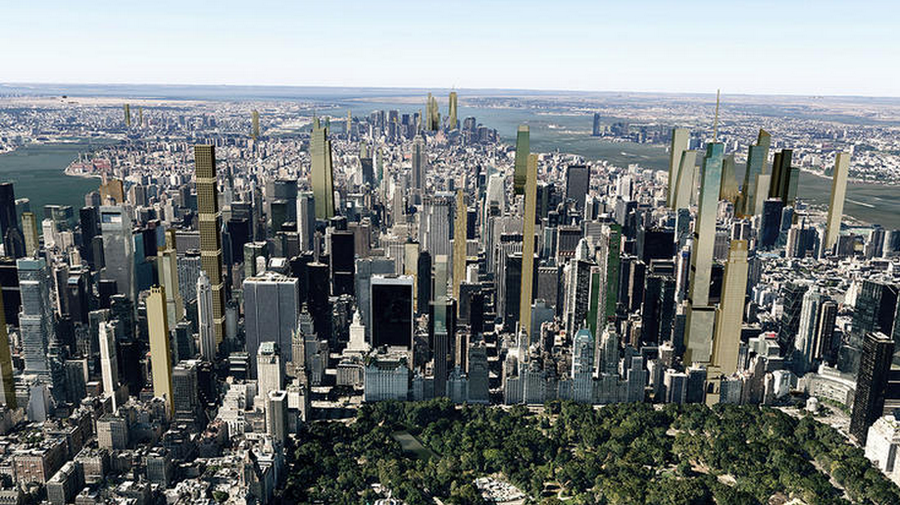http://www.citylab.com/housing/2014/...r-boom/382663/
There's Nothing to Fear From New York's Next Skyscraper Boom
Except for people afraid of heights, no one has any reason to worry about the coming wave of new towers.

KRISTON CAPPS
Nov 13, 2014
Quote:
When Nicolai Ouroussoff got a look at the building that Jean Nouvel designed for New York City back in 2007, he called it "the most exhilarating addition to the skyline in a generation." The architecture critic for The New York Times at the time, Ouroussoff name-checked the heavyweights in his review: Cass Gilbert, who designed the Woolworth Building; the Chrysler Building's William Van Alen; the god Mies van der Rohe. Even the 19th-century English art critic John Ruskin is summoned in praise of Nouvel.
The skyscraper in question, 53 W. 53rd Street, adjacent to the Museum of Modern Art, isn't finished yet. Construction has only just begun. But history has already vindicated Ouroussoff's untethered praise.
If New Yorkers once saw their skyline as the great citadel of capitalism, who could blame them? We had the best toys of all.
But for the last few decades or so, that honor has shifted to places like Singapore, Beijing and Dubai, while Manhattan settled for the predictable.
Perhaps that’s about to change.
It's no longer a question. There's now a date set for the return of new New York architecture: 2018.
That's the year that Nouvel's MoMA Tower at 53 W. 53rd Street, a Hines development, is scheduled to be completed—along with quite a few other projects in Midtown. CityRealty just released the rendering above to promote 53W53 and showcase what Manhattan will look like in 2018, once the many projects currently under construction or in development around Central Park are completed.
Not all of them are so beloved as Nouvel's tower. "One57 is Exhibit A in what we should be able to prevent," writes Michael Kimmelman, the present-day architecture critic for The New York Times, in a stern note last December. That project's architect, Christian de Portzamparc, like Nouvel, is a Pritzker Prize–winning designer. Rising 1,000 feet over Central Park at 157 West 57th Street today, One57 boasts penthouses that are reportedly selling for as much as $90 million—but it is not more admired for beating 53W53 to the punch. "It's anybody's guess how the building got past the drawing board," Kimmelman writes.
The CityRealty rendering includes these two projects and at least two-dozen more, most of them supertall skyscrapers clustered around Midtown's much-maligned Billionaire's Row. These aren't the finest renderings of the individual projects made to date, not by a long shot, but they do convey the scale of the skyscraper boom taking shape in New York right now.
While few of these projects have yet to arrive, they are already changing Manhattan in measurable ways. New York Daily News reporter Katherine Clarke runs down how Midtown residents are making way for the future now. Don't pity the millionaires being displaced by the billionaires too much: Some long-term residents are looking to sell their moderately priced (million-dollar) condos to "buyers who’ve been lured to the area by the dazzling new towers but can’t quite afford the price tags."
Clarke's report sounds a lot like filtering at work. Economic success drives metropolitan movement, and in Midtown Manhattan, economic success at the global level is creating the conditions whereby many who are not billionaires stand to gain. Increasing the supply at the luxury level, even at the stratospheric level, can help workers and residents of many different classes to move on up. Filtering is one reason why no one should fear the skyscraper boom: Eventually, it can help create the conditions of a more affordable New York.
Many critics don't see how building luxury pieds-à-terre for foreign billionaires helps anyone at all. The developer Ofer Yardeni is one of many who thinks that this unprecedented scale of luxury development indicates a residential bubble that is ready to pop. The Municipal Art Society has emerged as a locus of dissent regarding the cultural changes that a skyscraper boom augurs, especially regarding uses around Central Park.
.....While construction in Midtown has been defined by the emerging super-skinny supertall-tower typology—with relatively little square footage and few units—there are many more towers on the horizon in New York. The second wave of the skyscraper boom includes more modestly scaled towers, most of them about 600 feet in height, in places like Williamsburg, Long Island City, and Hudson Yards.
These buildings promise to increase residential housing at many scales, including rental housing, but they face long odds from incumbent homeowners and residents. Protests over the Domino Sugar factory development in Williamsburg have mostly subsided, but elsewhere—in Queens, Brooklyn, and in Harlem and on the Upper West Side—objections to planned developments still stand.
Such developments don't challenge the skyline the way that new supertall skyscrapers do (or the way that critics fear that they do). The key to building a more affordable New York by 2018 will be supporting the construction that complements the supreme-luxury residential towers in Midtown: Residential and rental buildings with some affordable-housing set-asides, yes, but also more condos. Rezoning Hudson Yards to allow more residential construction would be a start. Eliminating the punitive state limit on residential density would be even better. But acknowledging that increasing the supply—even high in the sky—can boost fortunes for everyone is crucial to the debate.
|

__________________
NEW YORK is Back!
“Office buildings are our factories – whether for tech, creative or traditional industries we must continue to grow our modern factories to create new jobs,” said United States Senator Chuck Schumer.
|



